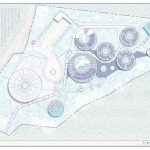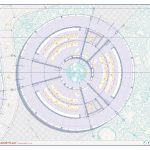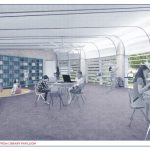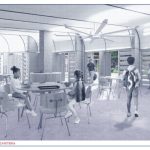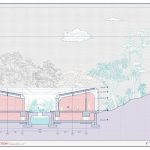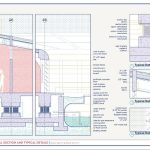Biomimicry: A solution to opposing forces?
“ What better way to learn about resilience than to adapt and study nature”. – Isabella Hillman, 2021.
Designer: Isabella Hillman
Thesis Committee Director (s): Prof. Rafael Vargas Correa
Thesis Committee Consultant (s): Prof. Luis Daza & Prof. Elvia Meléndez
Location: Guánica, Puerto Rico
Completion Date: May 2021
TOS [er]: Diego Hernández
Posted: May 2022
About Biomimicry:
Due to Earth’s global temperature increase, natural disasters have become more substantial and recurrent in the last two decades. The island of Puerto Rico is threatened by two types of recurrent natural disasters: hurricanes and earthquakes. These phenomena negatively affect a building’s structural integrity in different ways: a storm is likely to negatively impact a more flexible architectural structure and an earthquake a more rigid one. These opposing demands on buildings require architects to design structures to be resistant to high wind loads or seismic loads, but not always both. To solve this problem, I will seek answers through the concept of biomimicry. This design solution mimics nature as a resilient system that has evolved for more than 3.8 billion years. The Challenge to Biology Design Spiral by Carl Hastritch will be used as the primary resource to identify and translate natural models whose function resolves the design problem. First, a series of design objectives and procedures will be enumerated, documented, and analyzed. Those criteria, along with data compiled through the investigation, will be utilized to consult local biologists to help identify an endemic natural entity, whose functions meet the requirements analyzed in the first stage. Lastly, the biological model’s process to resist both phenomena will be mimicked and applied to the architectural design of a school, whose objectives are to resist the disaster and serve as shelter days after emergency events in Puerto Rico.
[Keywords: biomimicry, wind loads, seismic loads, hurricanes, earthquakes, endemic, nature]
Project description:
The project all started with analyzing the location and which was susceptible to a disaster. The project wanted to address a structure resistant to these disasters and to the climate change that has increased. Now more than ever we must address this problem that will increase due to climate change and our geographical location, was the motive for this thesis. Case studies of the importance of schools due to their role of refuge, education and essential service of the country were the essential role. This was because the most affected structures in municipalities, south part of the Island, were schools. The site in Guánica was chosen because it only had one open school and it was in critical danger. The psychological role schools play, a second home, and its not a place to be uncertain was one of the main reasons of the analysis. What better scenario to concluding in a self-sustaining, sustainable, resistant and safe design while learning about the Biomimicry. The importance of addressing the seismic and atmospheric vulnerability while protecting the environment and children is what this project concludes.
- Address seismic and atmospheric vulnerability of the island
- Base design of Biomimicry
- It’s environmental and sustainability compliance
- Creates a safe structure for shelter and education
Objectives:
The main objectives of this thesis are addressing the vulnerabilities in our shelter, educational and emergency system while learning from nature. As Isabella focus was “what better learn to protect ourselves from nature than learning and protecting it?’’. This project was made possible because the understanding of the needs and peculiarities of the site and region. While it can teach from it’s design the focus was to address and respond to Guánica. At the same time the population to protect and live in these spaces are the most vulnerable, children. The school proposed is a culmination of understanding the objectives and design around them. The Biomimicry based design is focused on new technologies while not trying to be a prototype.
- Focus on making a safer environment and structures
- Use emerging technologies based on Biomimicry
- Responds to site and context, not a prototype
Methodology:
The Biomimicry design methodology is whats used in this thesis. It’s known for being a “biological solution” based design. The Biomimicry Design Spirals are visual aids that illustrate the biomimicry design process. This was a stepping process that was divided in five phases: identify, interpret, discover, abstract, evaluate. While applying this methodology new technologies and 3d printing strategies were used.
- Design functionality model
- Biomimicry design spiral direct methodology
- Nature design learning while addressing sustainability goals
Design Strategies:
The design strategy was focused on the methodology, which was Biomimicry, representing nature. The case studies to make the design possible were the Puerto Rican Woodpecker and the sea urchin. While analyzing their strengths and weaknesses the design process addressed the seismic and atmospheric vulnerabilities in the school structures. The design strategy also responds to the climatic conditions of the south high temperatures. These two design strategies made the process simple and successful because of the straightforwardness. It concluded on radial plans and a green path that connects the school community with its environment.
Project Program:
The program was a school with integrated emerging technologies. The program was conceived for an integrated students and teaching community.
- Middle School of 250 students (300 persons capacity)
- 9 Classrooms (3 per Grade)
- Administration
- Library
- Cafeteria and Kitchen
- FabLab and Special Classrooms
- Assembly
- Recreational Facilities
- Parking
TOS [er] Reaction:
As a crisis and safe solving proposal this thesis project is successfully addressing the challenges while responding to its site and sustainability issues. This thesis analyses the vulnerabilities and learns from its native wildlife to overcome them while being environment friendly. The focused population has been the most affected by the recent natural disasters and government cuts, giving more importance to this project. The functionality and simple strategy for design and methodology made it possible to be clear and understanding in its solution. If the Biomimicry, seismic and atmospheric challenges not enough the project was executed successfully in an Eco Trail and radial plans design. While the project focused on Guánica we can certainly apply this strategy and proposal to other places on our island and world, which is more than clearly needed.


